Affiliate disclosure: This post may contain affiliate links. Please see our Privacy Policy.
Yellowfoot chanterelles are some of the most prized mushrooms anywhere, and with a little guidance, they’re the perfect beginner-friendly mushroom to forage. They’re flavor is absolutely spectacular, so it’s well worth learning to identify yellowfoot chanterelles!
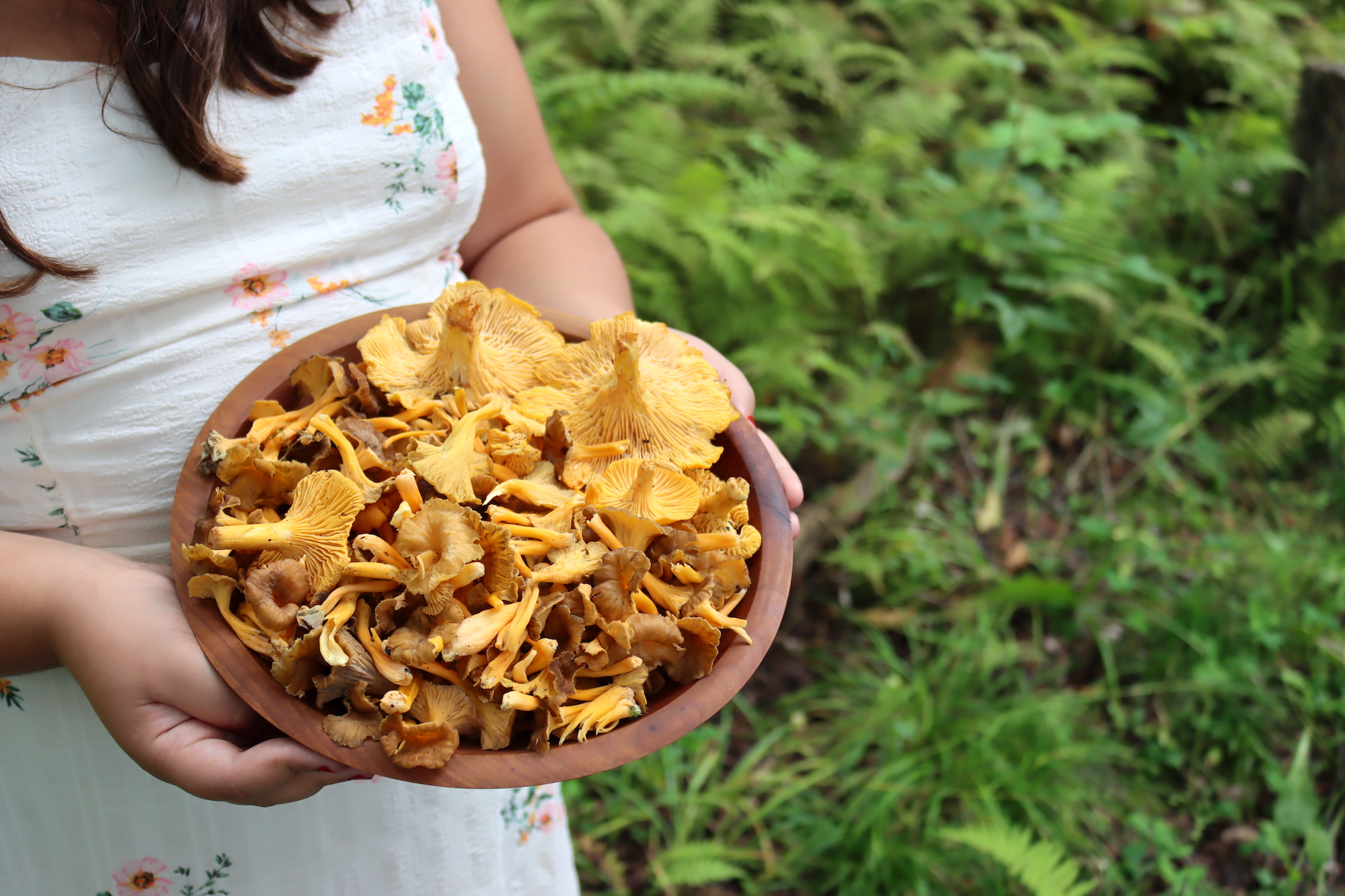
This article was written by Timo Mendez, a freelance writer and amateur mycologist who has foraged wild mushrooms all over the world.
Somewhere between the smell of peaches, fresh sawdust, and the rich aroma of a vanilla cake hot from the oven lies the delicate aroma of Yellow Feet Chanterelles.
While they don’t get the spotlight compared to their “golden chanterelle” counterparts, these are mushrooms that with proper preparation, easily rival their peers. And that’s precisely it. You need to know how to prepare these morsels for a pleasant experience. Don’t worry, we’ll get into that later.
One great thing about these mushrooms is that they are incredibly easy to identify. Due to their distinct characteristics, very few mushrooms look anything like them, making them a great species for beginner foragers. Plus, there’s an easy-to-follow rule, that along with proper judgment, can ensure the proper identity of this mushroom when you’re out in the field.
Yellow Feet is a common name readily used for several different species in the genus Craterellus, the most famous of which is Craterellus tubaeformis. They are also known as winter chanterelles, tube chanterelles, funnel chanterelles, or simply “tubies”.
Also, some people call them “Poor Man’s Chanterelle” due to the perceived notion that they are inferior mushrooms compared to their relatives. I’m telling you right now, this is blasphemy; this idea is just a cultural construct. These mushrooms are delicious. One of the reasons this idea persists is probably due to the fact that its “mushroomy” texture is disregarded by occidental culture, which tends to prefer “meatier” mushrooms. The other reason is probably that the flavor is subtle and requires a distinct preparation to shine through in a dish.
But hey, if people aren’t going to embrace this mushroom as a worthy edible, then more for us!

Natural History Of Winter Chanterelles
Yellow Feet Chanterelles are symbiotic partners with many different tree species, forming what is known as a “mycorrhizal relationship”. You’ve probably heard of this concept, where fungi trade nutrients from the soil for energy-rich sugars plants produce through photosynthesis. In exchange for these sugars, fungi also provide environmental services like protection from pests, disease, and extreme environments. Mycorrhizae means “fungus root” and it refers to the specific fungal structures found in plant roots where this exchange takes place.
Mycorrhizal fungi, like Yellow Feet Chanterelles, are only found in association with their tree hosts. It is the reason why they are (as of now) impossible to cultivate. In the case of Yellow Feet, they mainly occur with conifers, particularly Pine, Spruce, Hemlock, and Douglas Fir, although in some places they may occur with Oak and Beech.
Some sources claim Yellow Feet Chanterelles may have saprobic (decomposing) capabilities, largely because they are often found growing directly from pieces of rotting wood and organic matter. While it could be possible that they retained some of the digestive enzymes necessary to break down woody materials (which most mycorrhizal fungi have lost), there is no real proof of this, just speculation. They very well could also just be consuming the byproducts of decomposition caused by other fungi and bacteria.
Yellow Feet are typically a late-season mushroom that begins during or shortly after the peak season. It is likely their fruiting may be triggered by heavy rain events that saturate the soils and dropping temperatures. This late-season habit owes them the name “Winter Chanterelles” in parts like California and Oregon where they can easily fruit into the new year. This is the name I learned the mushroom by, which I and my mushroom foraging crew would shorten to just simply “winters”.

Biodiversity Of Yellow Feet Chanterelles
Historically, Yellow Feet Chanterelles were in the same genus as regular chanterelles (Cantharellus), but molecular evidence has suggested that they belong in their own genus called Craterellus. This genus contains well over 2 dozen species, including Black Trumpets, although most of them are pretty rare.
As previously discussed, several closely related species go under the name Yellow Foott Chanterelle. These are each distinct although some may look very similar to each other. It’s likely that with future genetic studies, the number of species may increase.
Craterellus tubaeformis
This is the most common and typical yellow foot chanterelle. The cap and gills are brown/tan colored and the gills are well developed. This is likely a species complex as it was originally described from Europe.
North America likely has its own, if not several, distinct species.
Some have used the name Craterellus neotubaeformis to describe the west-coast species. It is the only “yellow foot” found in the western United States and Canada.
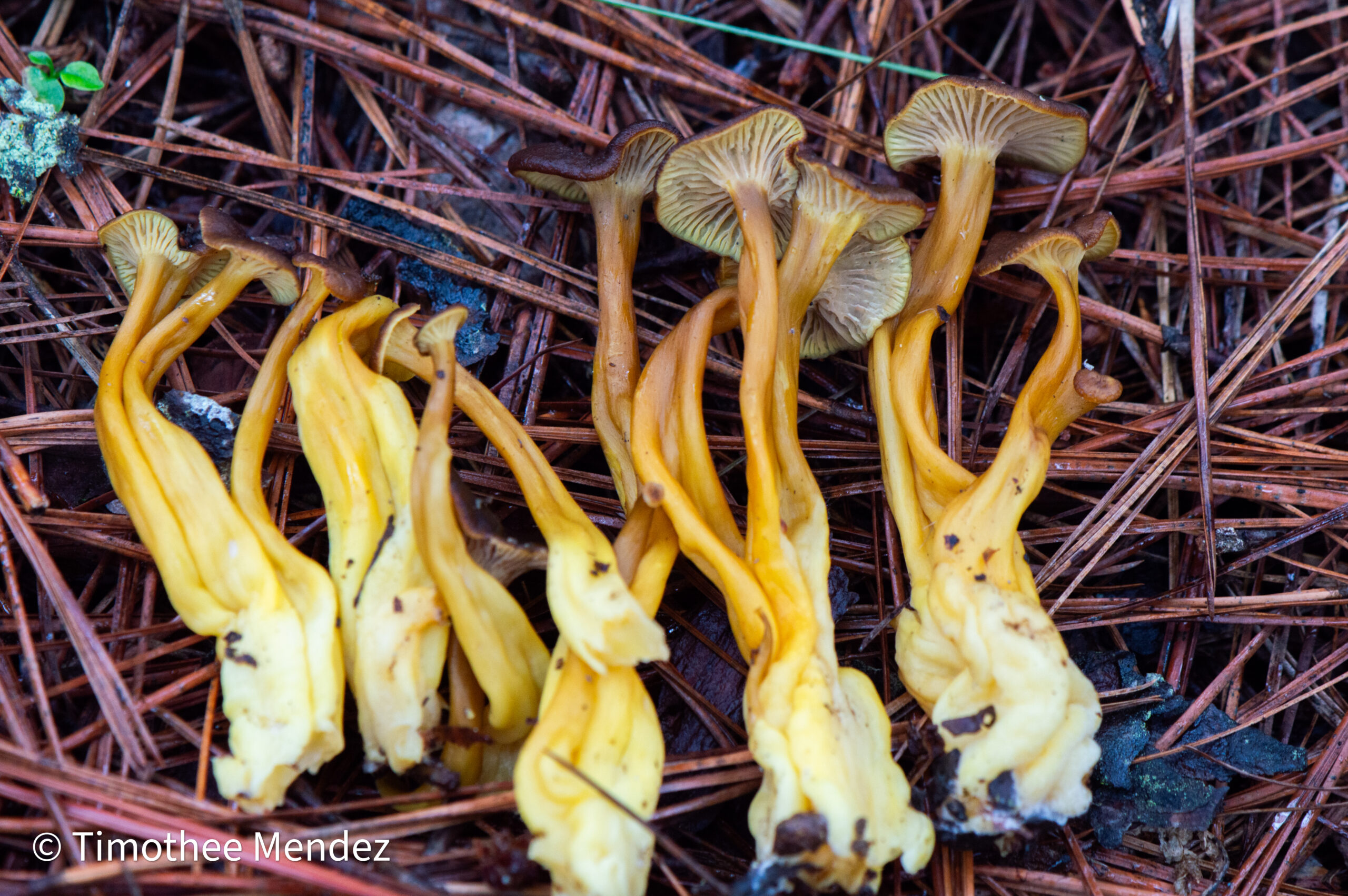
Craterellus ignicolor –
This is also sometimes known as the “Flame Chanterelle” due to its pink/red coloring.
This species occurs with hardwoods like Oak, Beech, and Birch, and grows well in warmer sub-tropical regions like Florida.
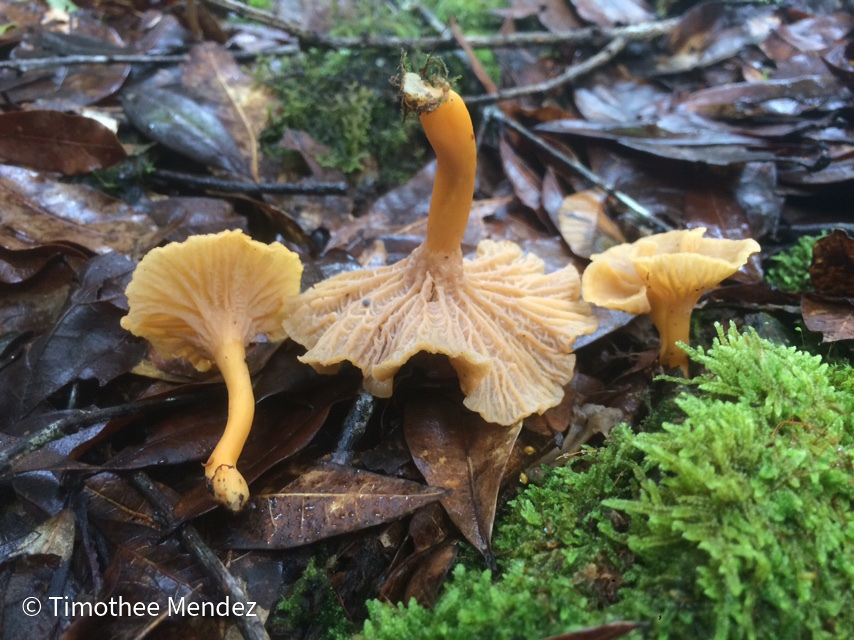
Craterellus lutescens
These look a lot like the other winter chanterelles except they have no real gills. Instead, they have a completely smooth undersurface.
In North America, these are pretty much limited to the Northeast, from Pennsylvania and above.
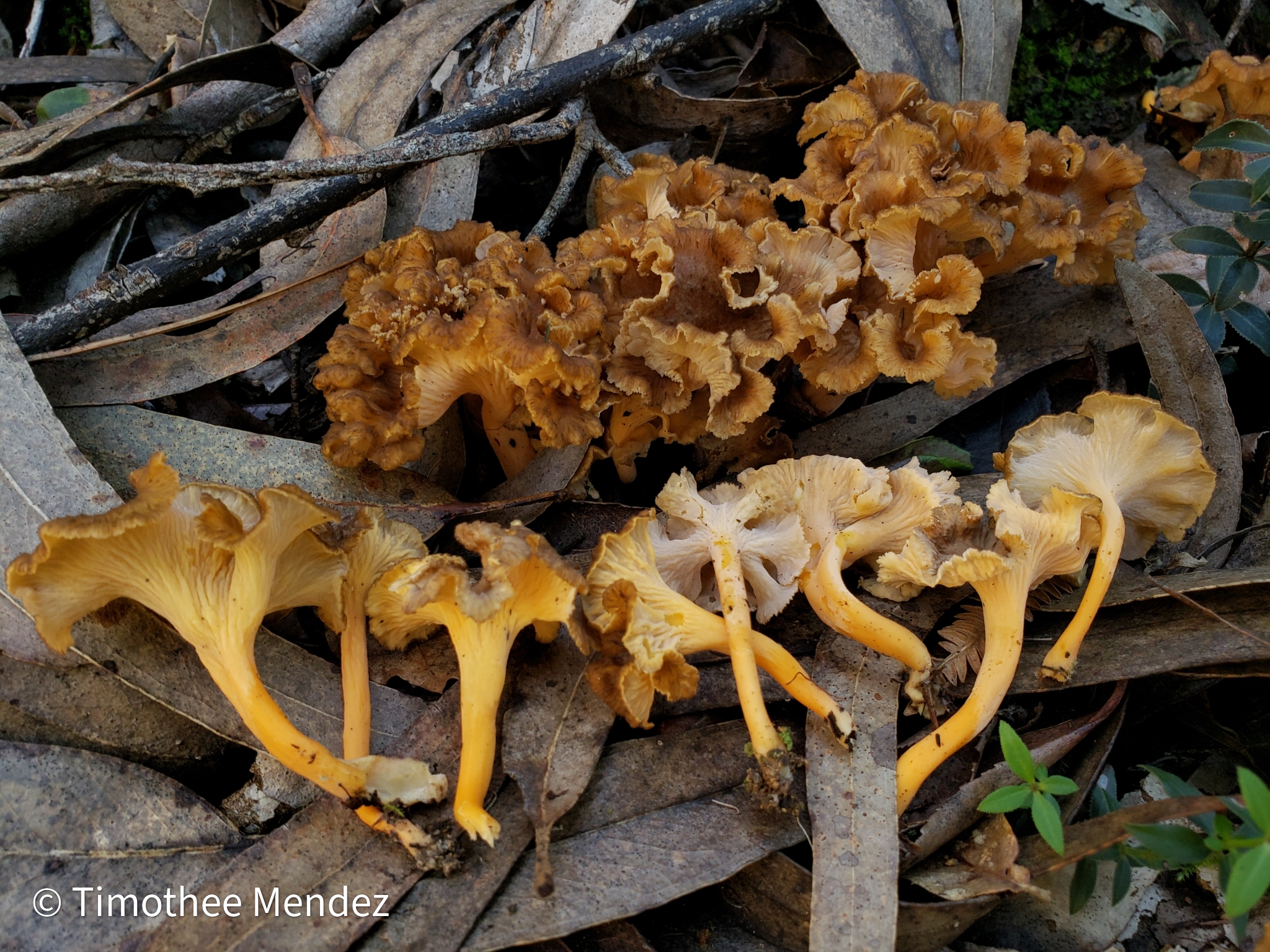
Some other close relatives include Craterellus undulatus and Craterellus sinuosus. Morphologically these fall somewhere between Yellow Feet chanterelles and Black Trumpets.
How To Identify Yellow Foot Chanterelles
Yellow Feet are pretty darn easy to identify and relatively safe compared to other types of mushrooms.
It makes them a great “beginner” mushroom for those who are still lacking mushroom-foraging confidence.
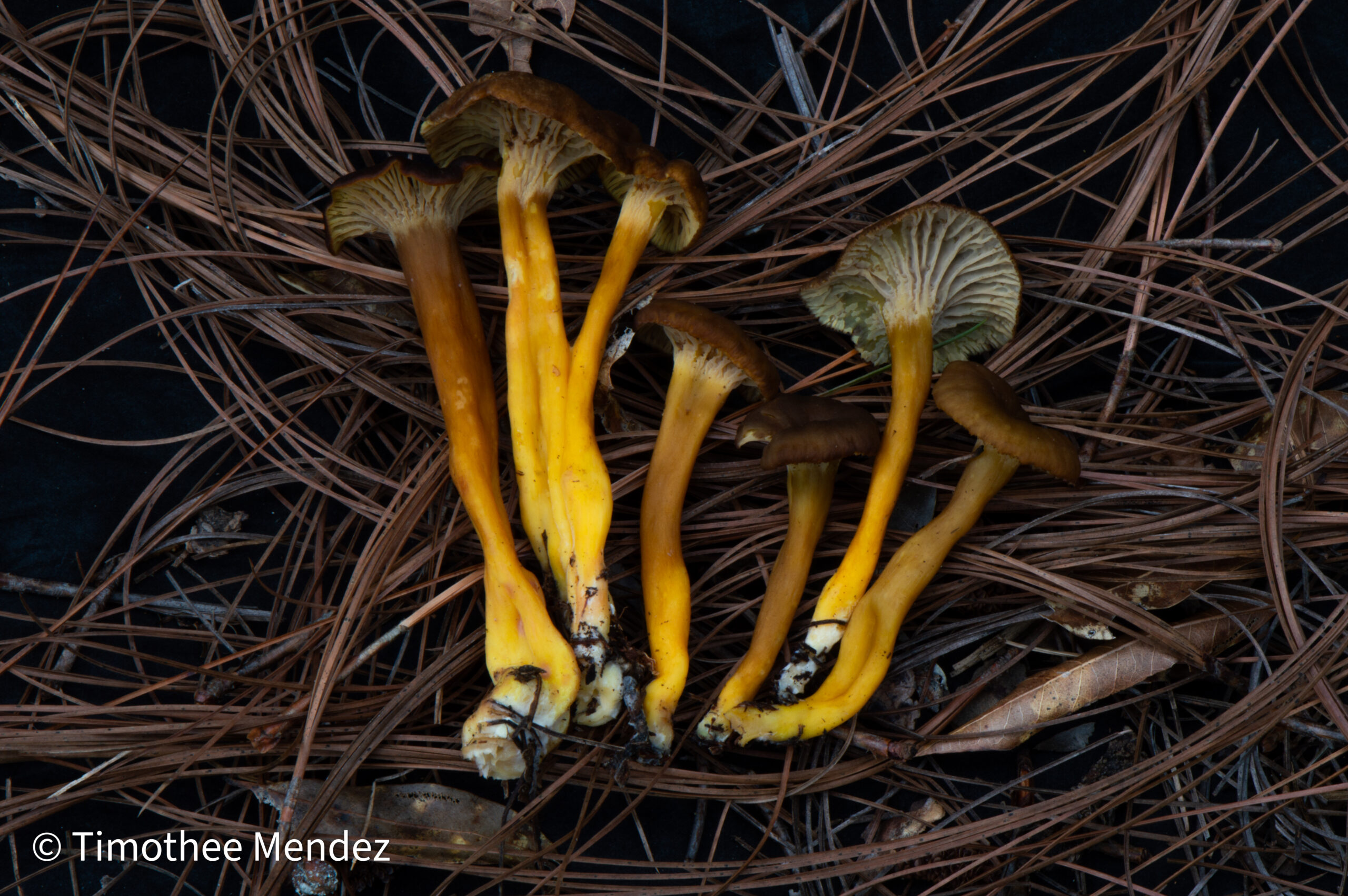
They are relatively small mushrooms, ranging from 3-10 cm in size. Occasionally, you can find massive ones. The first thing you’ll notice from a distance is that they typically grow in large patches or clusters and are rarely alone. Afterward, you’ll probably notice the brown-tan cap, which starts somewhat convex but becomes vase-shaped as it matures. The color often turns a bit gray with age. The underside of the cap where the gills are located is typically lighter in color. Craterellus ignicolor, the flame chanterelle, has a reddish-pink underside.
The stem is typically yellow and fading to white towards the base. It is no more than a cm in width. It is This yellow stem owes them the name “Yellow Feet.”
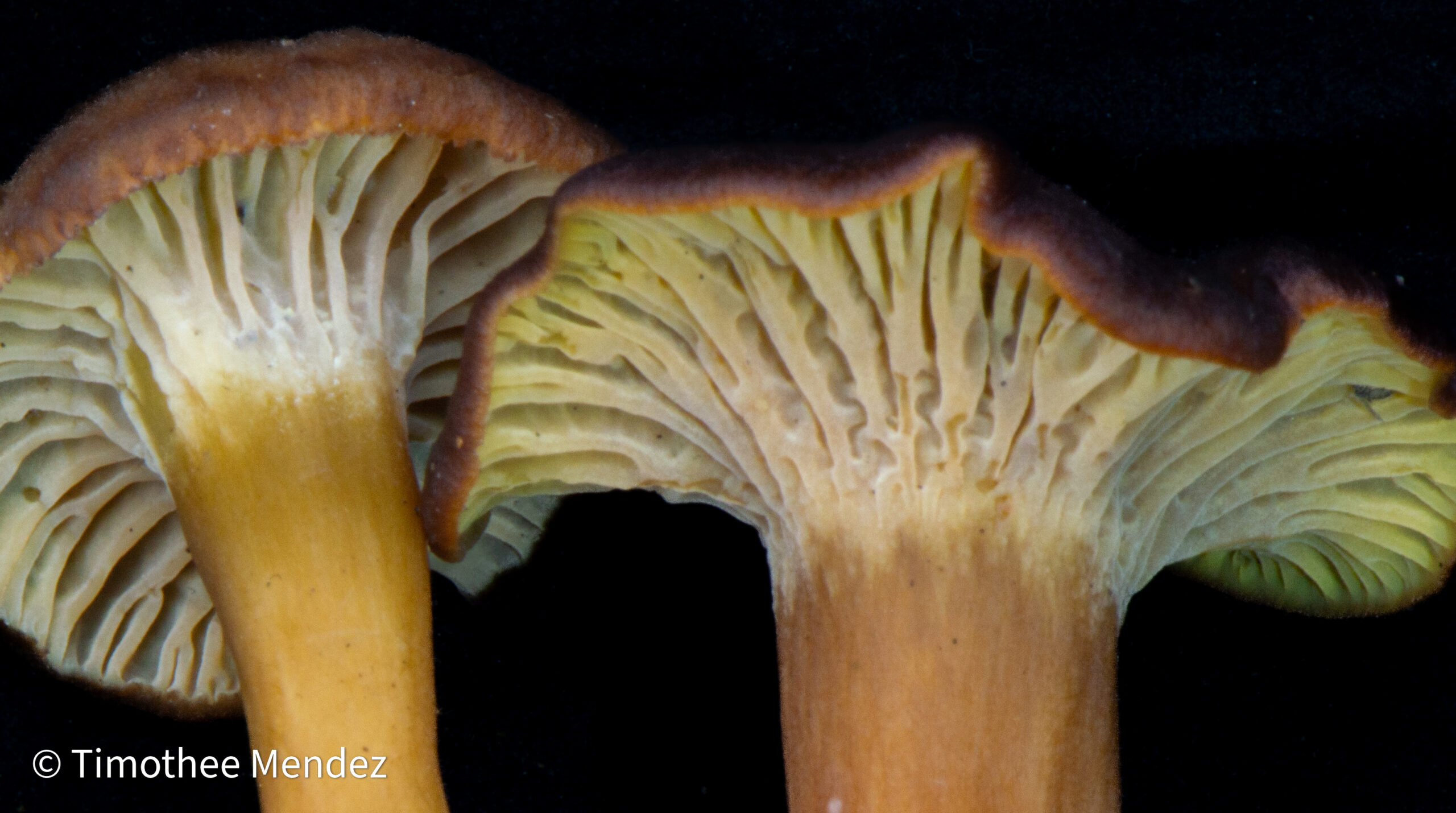
Observed more closely, one of the first things you’ll notice is the top of the stem has a “belly button” type hole on the top. This hole runs down the stem, resulting in a hollow mushroom with a “tube”. This hollow nature of the mushrooms owes it the name “Tube Chanterelle” (which is a translation from a French common name) and the scientific name Craterellus tubaeformis which refers to this feature. Indeed, the hollow nature of the mushroom is one of the key identification features of this mushroom.
The gills of Yellow Feet are similar to your typical chanterelles. They’re not deep like gills found in most other mushrooms where they almost look like pages in a book. No, instead the gills look like small ridges which run from the edge of the cap and down the stem. Species like craterellus lutescens have a completely smooth underside and no gills.
Diagnostic Features For Yellow Feet Chanterelles
- Typically small, ranging from 3-10 cm, occasionally larger.
- Often found in large patches or clusters, rarely solitary.
- The cap starts convex and becomes vase-shaped as it matures. The color is brown to tan, turning gray with age. Has a “belly button” like depression at the top.
- The stem is yellow, fading to white at the base. It is less than 1 cm in width.
- The entire mushroom is hollow and “tube-like”.
- Gills are not deep like other mushrooms. They resemble small ridges running from the edge of the cap and part way down the stem.
Yellow Foot Look-A-Likes
Yellow Feet are pretty distinct mushrooms and hard to mistake. They only have one close lookalike and differentiating them isn’t too challenging. This being said, only eat mushrooms when you have 100% confidence in their identification. Confirm with an expert if you have any doubts, and if you’re not sure, don’t eat them!
Jelly Babies (Leotia lubrica): These mushrooms have a similar color scheme as Yellow Feet but a completely distinct texture and structure. This being said young yellow feet could potentially be mistaken for this mushroom by a novice!
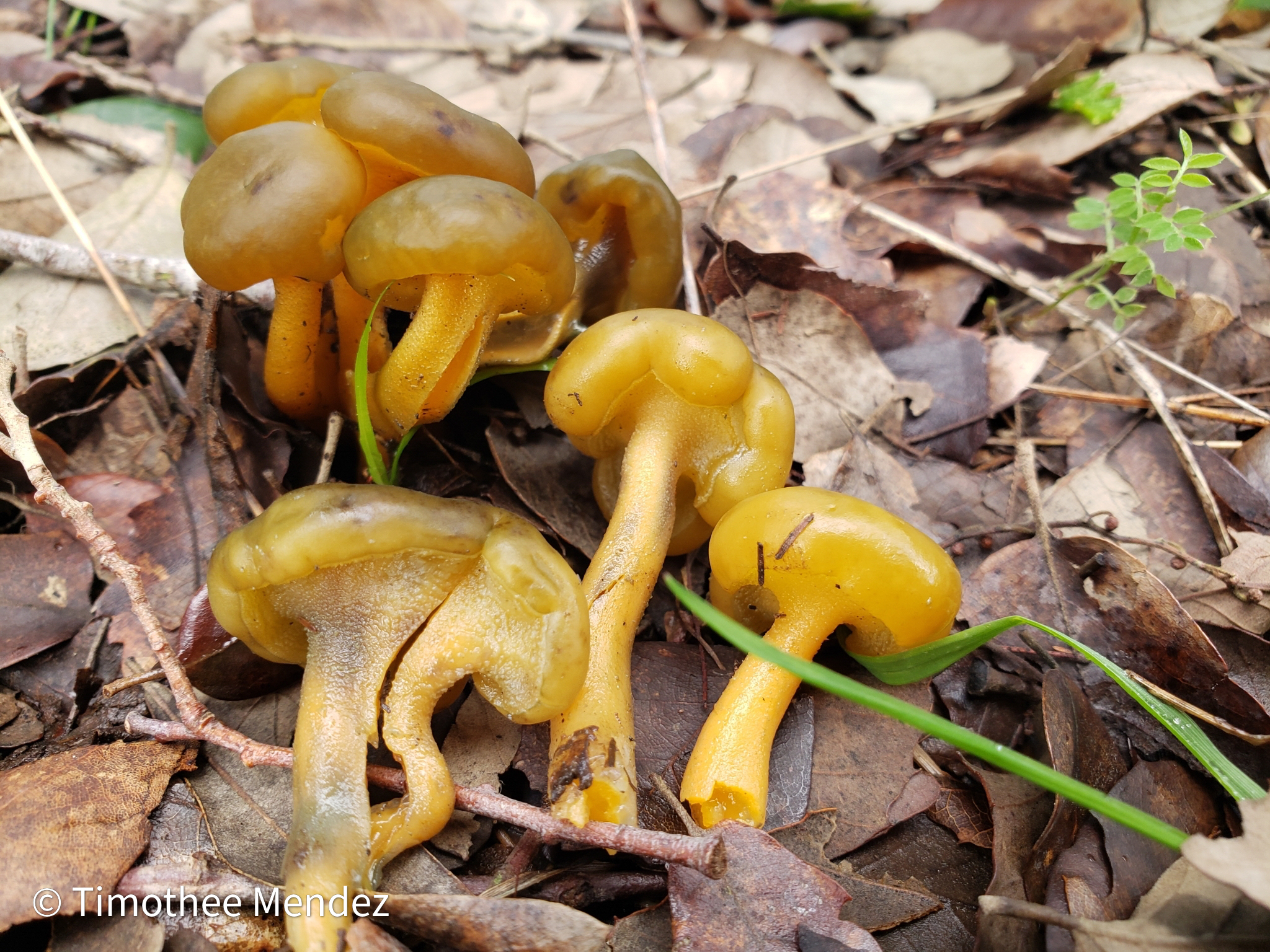
To begin, these are typically smaller and grow no larger than 5-7 cm. They are moist, shiny, and extremely gelatinous. When you hold them they feel almost slippery to the touch. They do not have a real cap like yellow feet, just a dense brain-like ball at the top.
This false cap is typically brown, although it can either be full or have tinges of green. If you have any doubts, cut them in half. Jelly Babies are completely solid through the middle while Yellow Feet are hollow.
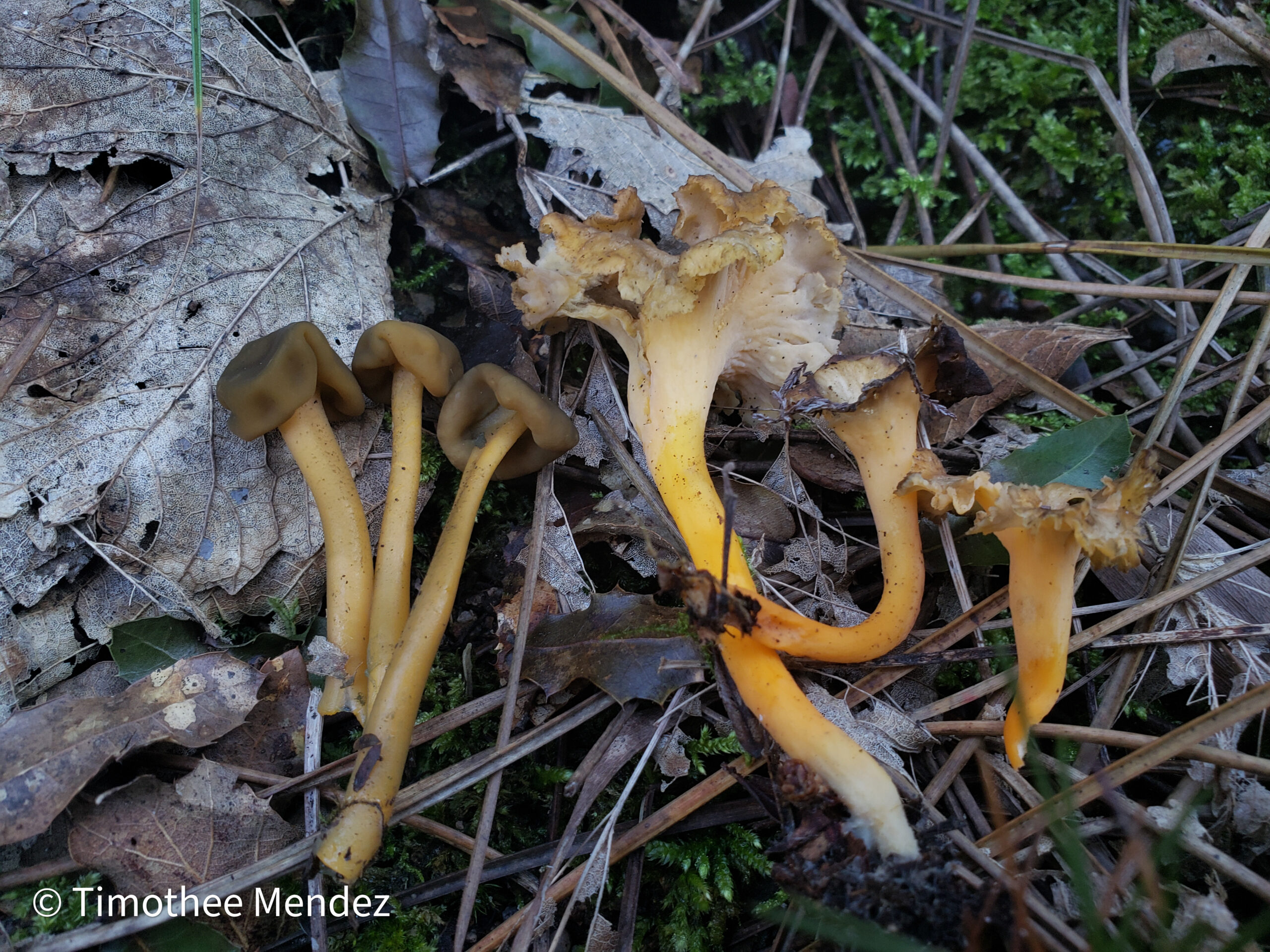
Where to Find Yellow Foot Chanterelles
Yellow Feet mostly occur in coniferous forests, although they can be found in hardwoods. They love lush habitats with an abundance of moss and partially decayed woody organic matter.
Some of the best habitats I’ve seen for Yellow Feet Chanterelles are swampy coniferous bogs. I’ve seen this for myself in the western United States with Spruce and Hemlock, but I’ve heard similar tales from the midwest and eastern United States. Something about these very wet environments allows these mushrooms to thrive and appear in abundance.
Oftentimes times you find ginormous flushes growing from moss-covered logs in these bogs. Part of me wonders if they really love this habitat or if it’s just a habitat many other mushrooms can’t handle, thus they dominate it. This being said I’ve found Yellow Feet in a diverse array of forest habitats and soils.
Western United States and Canada
In the Western United States, you can Yellow Feet Chanterelles from Alaska down to about central California. Here it associates with Sitka Spruce (Picea sitchensis), Hemlock (Tsuga heterophylla), and Douglas Fir (Pseudotsuga menziesii). It predominates in coastal zones and along the western slopes of the coastal range.
In Oregon and Washington, it can be found along the Cascades, and in Canada into the Rockies. It is only known from the coastal states and not known to occur in the American Rockies or the Southwestern Sky Islands. In the west, Yellow Feet often coincides with Belly Button Hedgehogs (Hydnum umbillicatum).
Eastern United States and Canada
In Eastern North America you can find Yellow Feet chanterelles in almost any coniferous, hardwood, or mixed forest.
In the southeast, Yellow Feet are largely distributed in the Appalachian mountains. This stays true for the central-eastern states but then in the northeast, they become more widespread. They are also pretty common in regions directly around the Great Lakes. In the deep south, true Yellow Feet are a bit scarce, but the Flame Chanterelle (Craterellus ignicolor) is more common and readily found along the Gulf.
Europe
In Europe, Yellow Feet Chanterelle is pretty widespread and can be found in many different forest types. Pretty much any region with Beech, Oak, Pine, and other conifers can be suitable for finding at least one of the “Yellow Feet” species. In some places, like Portugal, they are even believed to associate with Eucalyptus.
They tend to like very moist and mountainous regions such as the Pyrenees, the Alps, Atlantic Europe, and Boreal Europe. Meanwhile, they are relatively rare in continental (northern Germany, Poland, etc.) and Mediterranean (Spain, eastern France, Italy, etc.) zones.
Global Distribution
Yellow Feet Chanterelles can be found in almost any temperate forest with adequate hosts. They are found in Mexico, Central America, Australia, China, Japan, and Columbia. Yellow Feet have even been introduced in some parts of the world such as South Africa.
When Is Yellow Feet Chanterelle Season?
- Western United States and Canada (Oct-March): In most of the Western United States, “Winter Chanterelles” (as they’re called there), are considered a fall-winter mushroom. In the southern parts, such as in California, its range the season tends to start around November and finish in March, while in Washington it can start as early as September and last till about February. In Alaska, the season starts much earlier around July, and lasts briefly until October.
- Eastern United States (July – November): In the Eastern United States they tend to be more of a Summer and Fall Mushroom with the season peaking around September. The season tends to start earlier and finish earlier as you go north into Canada.
- Europe (Aug – Dec): In Europe, the season depends on where you are. In northern regions like Denmark, the season is shorter spanning from September to November at the latest. In warmer regions like France and Spain, the season extends easily into December. In Portugal, you can find them into January or February!
How To Harvest Winter Chanterelles
To begin, as always, harvest with respect for the ecosystem and the local people. Don’t leave trash, trample native vegetation, or do anything unruly. Harvest with permission from landowners if necessary. With Yellow Feet, I tend to leave at least 25%, if not more, when I find them, just because there are often a lot of small ones that aren’t even worth picking. This also ensures to leave some for wildlife, other pickers, and for the sake of letting it do its thing.
Yellow Feet are relatively small mushrooms and thus harvesting can be a bit labor-intensive. Sure it’s not back-breaking (unless your picking commercially!), but you won’t fill your basket with just a couple of mushrooms like you can with Boletes. Don’t be afraid to get down onto your knees, because oftentimes that is just the easiest way to pick these small buggers. Yes, you may end up getting a bit wet in the process! Thankfully, there is often an abundance of moss and leaf litter where these grow.
I recommend harvesting these with either a knife or simply by pinching them at the stem while you pick. This will save you a ton of cleaning work later on. Don’t put them in a basket/bag with the dirty stem butt as this will result in much more cleaning later on.
It is not uncommon for these mushrooms to coincide with Belly Button hedgehogs or other small edible mushrooms. If you’re already getting down to pick the Yellows, might as well throw in some Hedgies too!
Yellow Feet are rather delicate and can easily get crushed by larger mushrooms if thrown together in a basket. Consider carrying a separate bag/basket for the larger more bulky mushrooms. A breathable hard plastic container that fits in your basket can also be a great way to keep them protected.
For storage, it is best to keep these in the fridge inside a breathable container. Try not to wait too long before using them, and it’s better if you clean them before storing them as well!
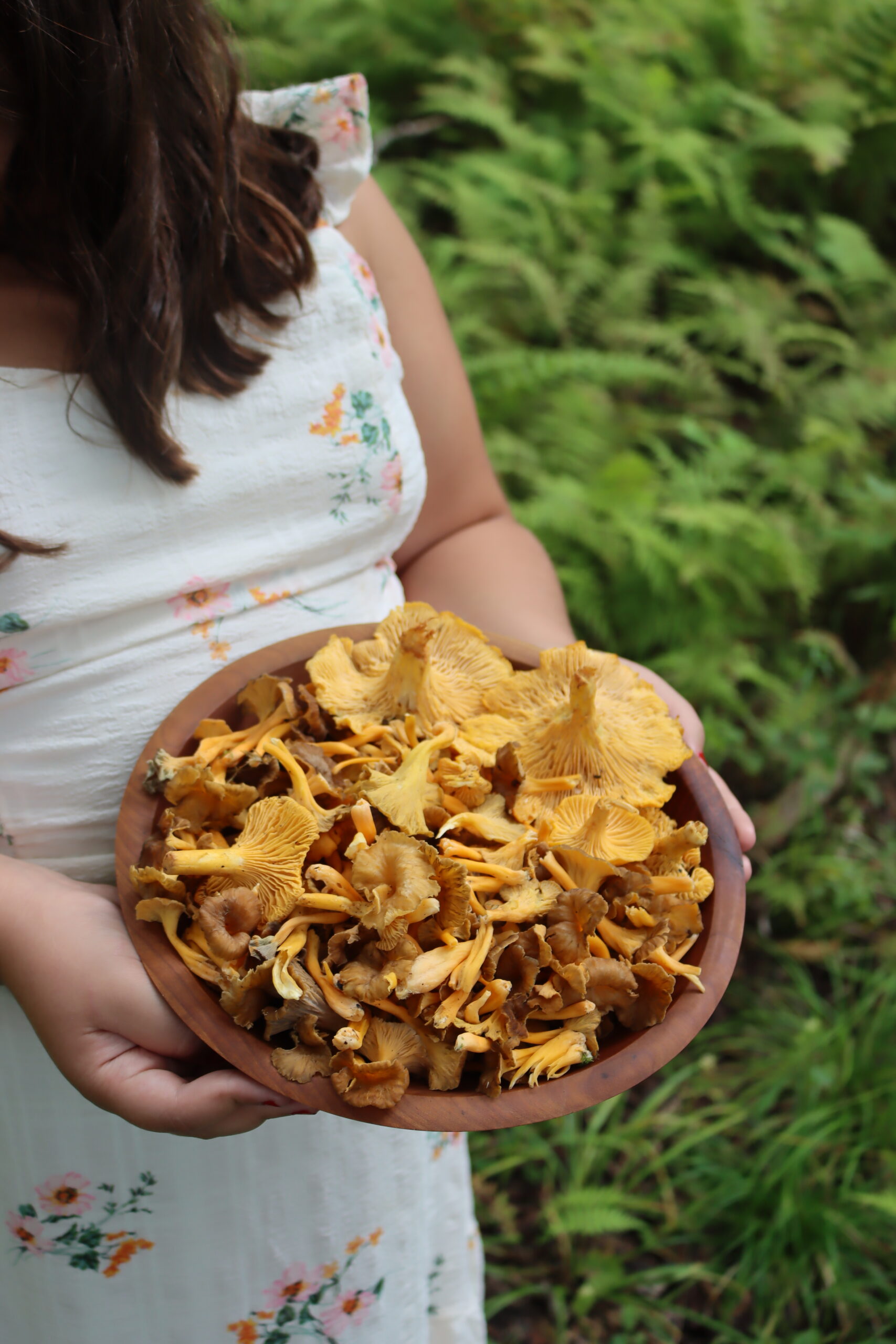
Cleaning Yellow Feet Chanterelles
First things first, you’re going to want to clean your mushrooms. If you picked cleanly, cut off the stem butts, and avoided crushing your mushrooms then this should be an easy task. Simply get rid of any pine needles or dirt that may have made their way in there.
If they got significantly dirty, then my personal recommendation is to wash them thoroughly in water. You can place them in a bowl and temporarily submerge them. Don’t worry too much about them absorbing water, just don’t leave them sitting in the water.
Once rinsed and drained, you’re going to want to let these air-dry to remove any excess moisture. You can place them evenly spread out on a large piece of cardboard until they’ve lost their shine from being completely saturated. This could take anywhere from a couple of hours to a whole day. A fan can help speed this process if needed.
If you don’t have time to let them air-dry, then I recommend washing them the old-fashioned way with a brush and knife. You can also blow into the gills with a good gust of air to remove any odd pieces of dirt. Cooking them when they are soggy with water may result in a slimy experience.
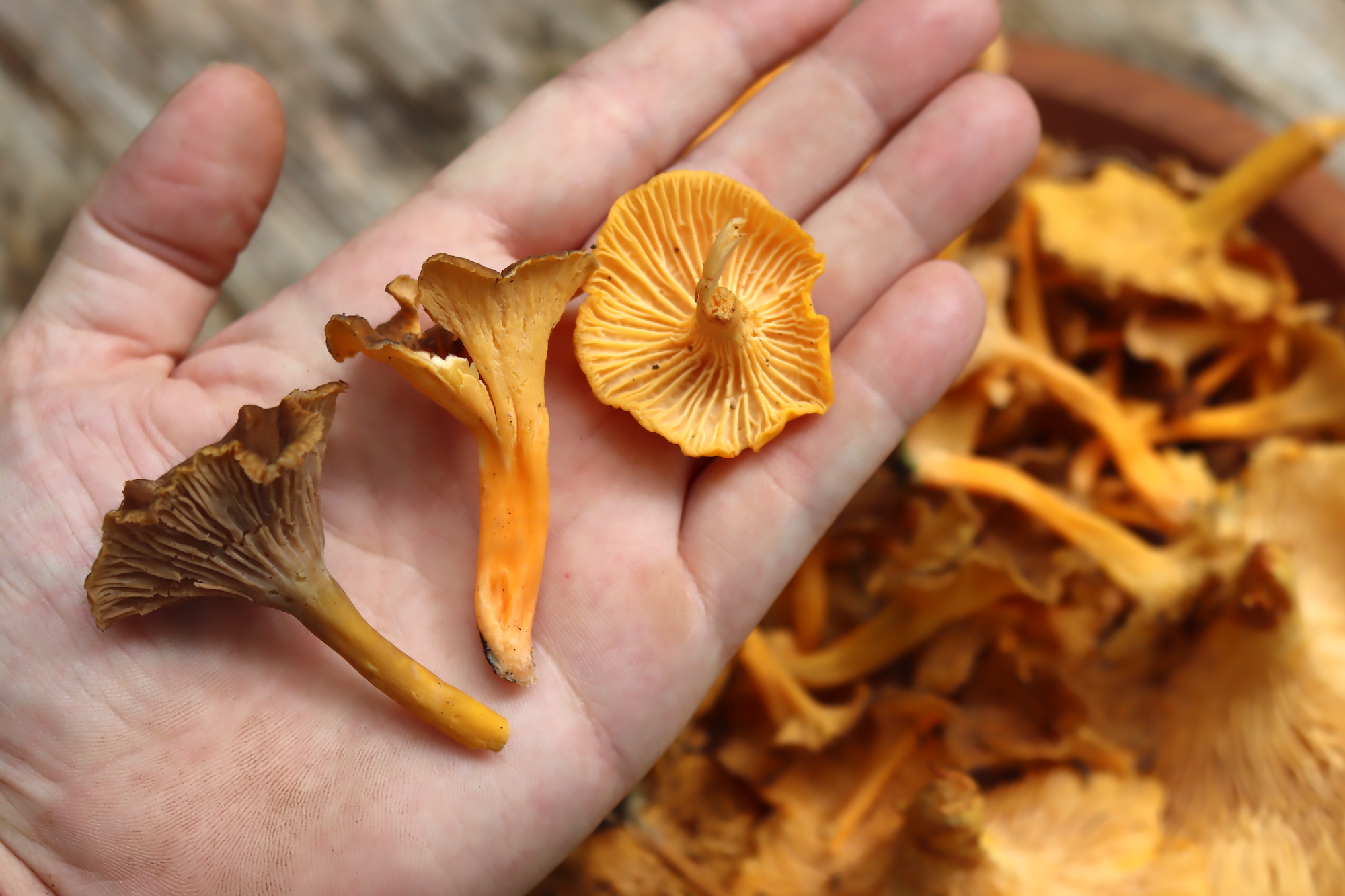
Cooking Yellow Feet Chanterelles
There are many ways to cook yellow feet chanterelles. Many people prefer to do the “dry sautee” method where you add them to a hot pan with no oil and let the mushroom release their moisture. Once all the water has evaporated, oil is added and the mushrooms are fried. This tends to result in a drier texture. If you have no patience for this, I also find them perfectly fine thrown directly into the hot oil. Don’t tell the dry-sautee fanatics I said this!
I’ll be straight up at this point and tell you that this mushroom doesn’t have the meaty texture of a true Chanterelle, Maitake, or Chicken of the Woods. It shrinks in size, wilts, and becomes a bit more goey than these other prized species. While many occidental folks don’t appreciate this texture, it is highly revered in other parts of the world, so don’t play it off too quickly. Especially since the flavor is delicious!
One of my favorite ways to cook them is to almost completely dehydrate them. This can be done on a griddle or with an oven that has its door slightly opened to let the moisture out. This results in crispy delicious mushroom treats! If you don’t like them any other way, this is something to dry before completely disregarding them.
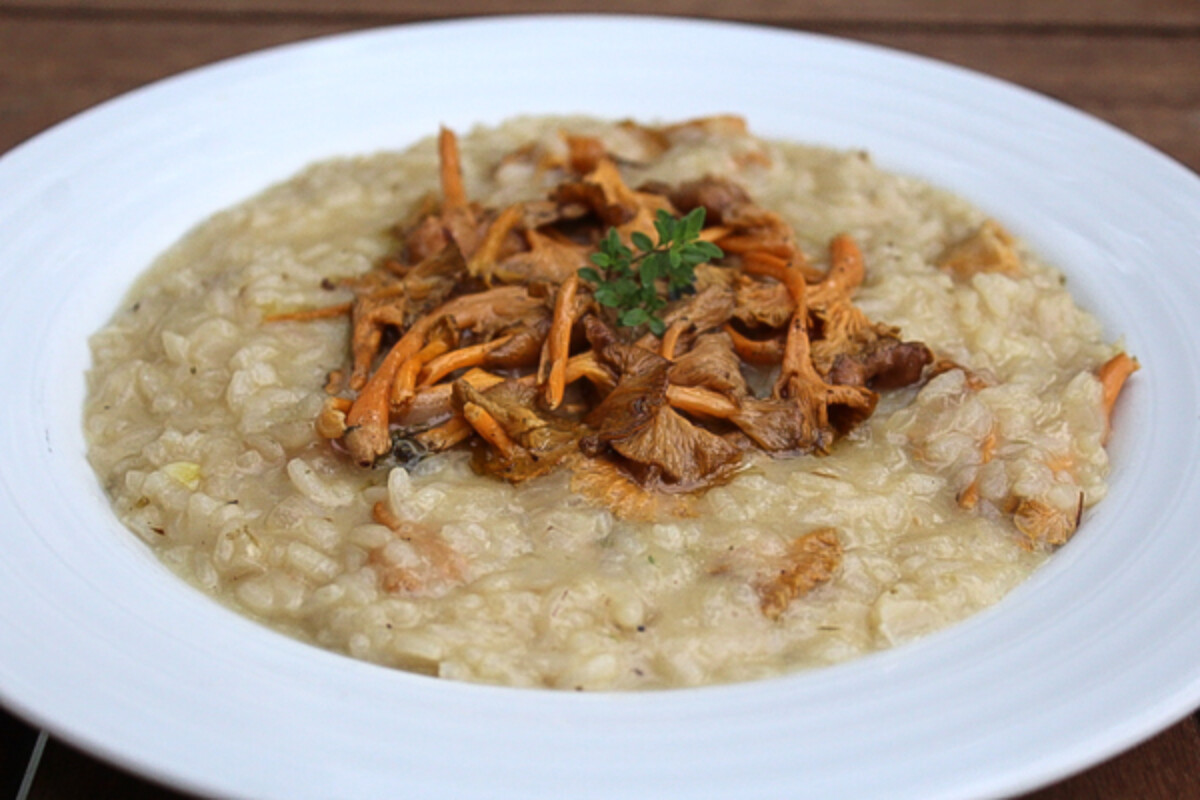
We tend to make simple, rich dishes like chanterelle risotto or a chanterelle cream sauce that we serve on crisp bread for a simple, yet elegant chanterelle toast.
Since fresh yellowfoot chanterelles have a peach/apricot aroma, you can also go in a sweet direction and make something like chanterelle cheesecake, creme brule or even chanterelle ice cream!
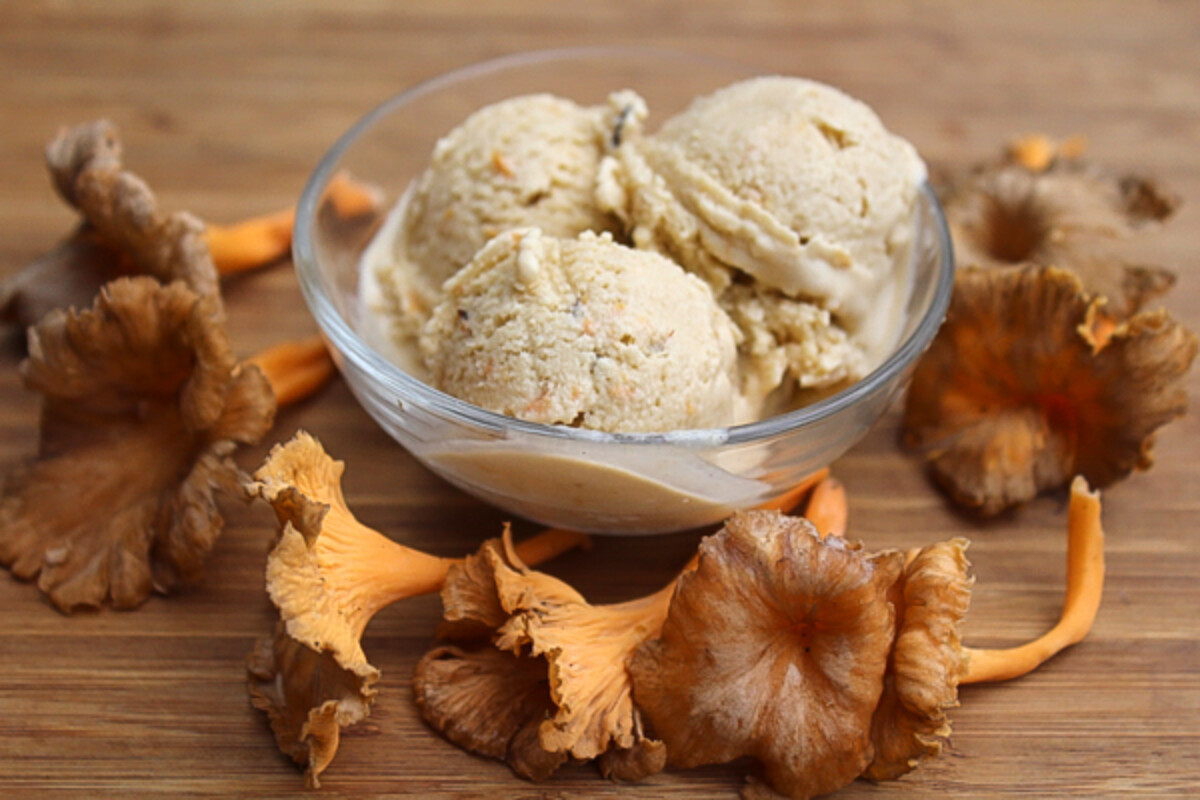
Preserving Yellow Feet Chanterelles
Sometimes, you end up with way more golden treasure than you can possibly use…and it’s time to get preserving!
Freezing
Don’t freeze raw mushrooms! They’ll become an extremely slimy and gooey texture. Instead, cook them first in your preferred method and then freeze them. Many people like to go partway through the dry sautee and then freeze them along with their juice.
Drying
While they won’t keep the same texture or flavor, it is completely possible to dehydrate them. The texture will be a bit chewier and firmer than the fresh specimens but it’s still enjoyable. Dried Yellow Feet go great in soups, stews, and anything you throw in the slow cooker! You can also powder them to make an instant mushroom seasoning.
Jerky
Yes! You can make jerky with these buggers! Simply cook them with your favorite seasonings and then dehydrate them. Perfect snack for the outdoors!
Other Preservation Methods
I don’t personally recommend canning or pickling these mushrooms. This will likely result in an extremely slimy experience!
Mushroom Foraging Guides
Looking for more wild edible mushrooms in the woods? These mushroom identification guides will help you quest!
- Morel Mushrooms
- Chaga Mushrooms
- Birch Polypore
- Tinder Polypore
- Witches Butter Mushrooms
- Puffball Mushrooms
- Shaggy Mane Mushrooms
- Reishi Mushrooms
- Turkey Tail Mushrooms
- Dryad’s Saddle


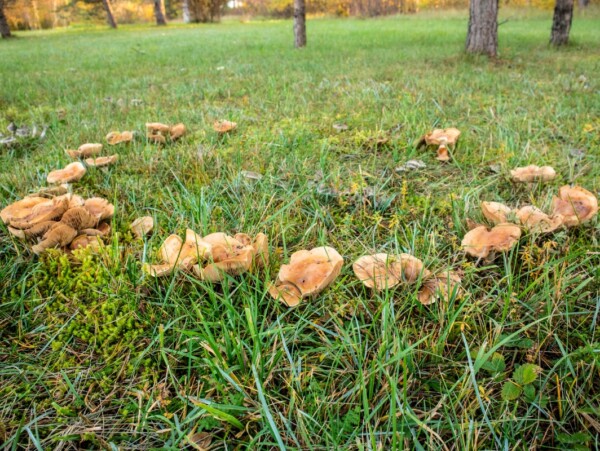
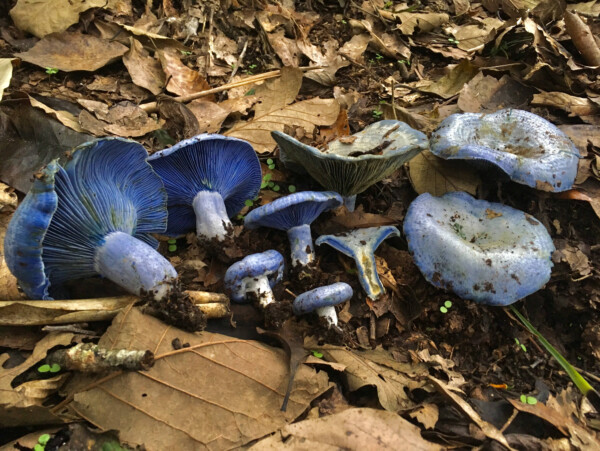
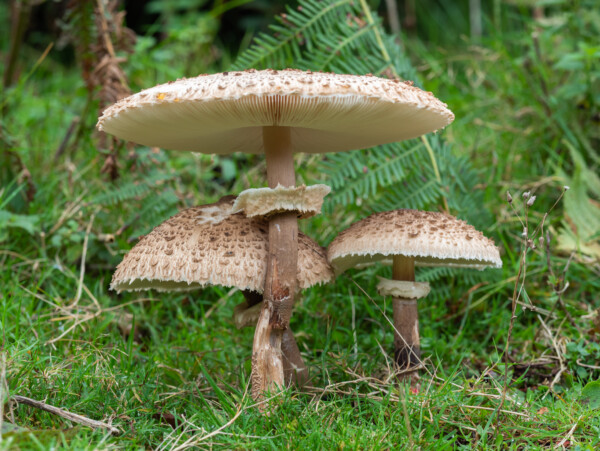










Hi Ashley. I just sent a request to your email asking for you to be an endorser for my new book Foraging as a Way of Life. Let me know if you are interested. No pressure:) You are mentioned in the acknowledgment. Thanks for sharing your knowledge in such a marvellous way. With Kindness, Mikaela Cannon
Thanks Mikaela! I just got a chance to look at it and it looks great. Your section on White Chanterelles was lovely, and would be helpful to anyone reading this chanterelle foraging guide! But I easily learned a dozen new plants paging through it. Thank you so much for sending it along, and I’ll be happy to get you an endorsement; you’ve crafted a lovely foraging book and people should know about it!